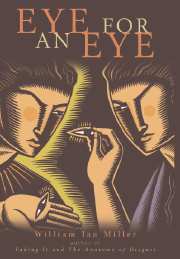Book contents
- Frontmatter
- Contents
- Preface: A Theory of Justice?
- 1 Introductory Themes: Images of Evenness
- 2 The Talion
- 3 The Talionic Mint: Funny Money
- 4 The Proper Price of Property in an Eye
- 5 Teaching a Lesson: Pain and Poetic Justice
- 6 A Pound of Flesh
- 7 Remember Me: Mnemonics, Debts (of Blood), and the Making of the Person
- 8 Dismemberment and Price Lists
- 9 Of Hands, Hospitality, Personal Space, and Holiness
- 10 Satisfaction Not Guaranteed
- 11 Comparing Values and the Ranking Game
- 12 Filthy Lucre and Holy Dollars
- Conclusion
- Notes
- Works Cited
- Index
4 - The Proper Price of Property in an Eye
Published online by Cambridge University Press: 18 December 2009
- Frontmatter
- Contents
- Preface: A Theory of Justice?
- 1 Introductory Themes: Images of Evenness
- 2 The Talion
- 3 The Talionic Mint: Funny Money
- 4 The Proper Price of Property in an Eye
- 5 Teaching a Lesson: Pain and Poetic Justice
- 6 A Pound of Flesh
- 7 Remember Me: Mnemonics, Debts (of Blood), and the Making of the Person
- 8 Dismemberment and Price Lists
- 9 Of Hands, Hospitality, Personal Space, and Holiness
- 10 Satisfaction Not Guaranteed
- 11 Comparing Values and the Ranking Game
- 12 Filthy Lucre and Holy Dollars
- Conclusion
- Notes
- Works Cited
- Index
Summary
We have two competing visions of days gone by. They are either times of torture, mutilation, human sacrifice, humans living short, nasty, brutish lives, or they are the good old days of decent simplicity, duty, dedication, and true love. The Aztecs, the Romans, and the various horse peoples who occupied the vast steppes of Asia, and occasionally decided to visit their sweetness and light on peoples to the west and south of them, provide us with plenty of ammunition to justify the first; and period-piece movies featuring the English gentry or our own self-deceptions about our grandparents and our childhoods we claim as proof of the latter.
Probably no reader of this book has a hard time believing that people actually carved up bodies in the bad old days, so why, you might ask, am I taking so much time to prove that an eye for an eye meant an eye for an eye? Of course it did, you will say. And I am certainly not about to deny that people mutilated humans in war, as they still do today, or as part of religious festivals, or to train doctors and make medicines, but my claim is more than that: it is that bodies and body parts were understood by them to be measures of value (clearly), as obligation-creating (clearly), and also as a means of payment – that is, as obligation-discharging (clearly in the case of whole bodies, as in matters of debt slavery or chattel slavery, marriage, fostering, and hostage taking, but also, a little less clearly to be sure, with body parts).
- Type
- Chapter
- Information
- Eye for an Eye , pp. 46 - 57Publisher: Cambridge University PressPrint publication year: 2005

